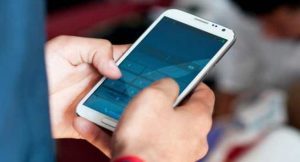- Home
- Editorial
- News
- Practice Guidelines
- Anesthesiology Guidelines
- Cancer Guidelines
- Cardiac Sciences Guidelines
- Critical Care Guidelines
- Dentistry Guidelines
- Dermatology Guidelines
- Diabetes and Endo Guidelines
- Diagnostics Guidelines
- ENT Guidelines
- Featured Practice Guidelines
- Gastroenterology Guidelines
- Geriatrics Guidelines
- Medicine Guidelines
- Nephrology Guidelines
- Neurosciences Guidelines
- Obs and Gynae Guidelines
- Ophthalmology Guidelines
- Orthopaedics Guidelines
- Paediatrics Guidelines
- Psychiatry Guidelines
- Pulmonology Guidelines
- Radiology Guidelines
- Surgery Guidelines
- Urology Guidelines
Blood sugar control improves with text messaging in diabetes, finds clinical trial

A low-cost text-messaging programme improves blood sugar control in patients with diabetes and coronary heart disease,finds the CHAT-DM randomised trial . The findings of the clinical trial were reported at ESC Congress 2019 together with the World Congress of Cardiology (1) and published in Circulation: Cardiovascular Quality and Outcomes. (2)
Study author Dr Xiqian Huo of the Fuwai Hospital, Beijing, China said: “The effect in this study was not only statistically significant but also has the potential to be clinically relevant by reducing risk of diabetic complications and death.”
“Capitalising on the exponential growth in mobile phone usage over the past decade, a simple text-messaging programme could increase the reach of diabetes self-management support,” she added. “It may provide a means to better address the burgeoning healthcare demand-capacity imbalance.”
CHAT-DM enrolled 502 patients from 34 clinics in China. In addition to usual care, patients were randomly assigned to the text messaging intervention or a control group for six months. The intervention group received six messages per week, at random times of day, from an automated system set up by the researchers. Topics included diabetes and coronary heart disease, glucose monitoring and control, blood pressure control, medication adherence, physical activity, and lifestyle recommendations on diet, foot care and emotional management. The control group received two thank you text messages per month.
At six months, blood glycated haemoglobin (3) (HbA1c) was significantly lower in the intervention group compared to control group (6.7% versus 7.2%). On average, HbA1c fell by 0.2% in the intervention group and rose by 0.1% in the control group – a difference of 0.3% between groups.
To reduce the complications of diabetes, the target HbA1c is less than 7%. Significantly more participants in the intervention group achieved the target (69.3%) compared to the control group (52.6%). The change in fasting blood glucose was larger in the intervention, compared to control, group (-0.5 versus 0.1 mmol/L, respectively).
Systolic blood pressure, low-density lipoprotein (LDL) cholesterol, body mass index, and self-reported physical activity did not differ between groups. The intervention was acceptable to participants, most of whom (97%) found the text messages useful, readable, and an appropriate method of contact.
While the study did not measure which text messages were most effective, Dr Huo said: “Lifestyle advice such as strict dietary control may have contributed to glycaemic improvements, together with reminders to monitor blood glucose regularly. The messages were designed to provide information and motivation, and help patients set goals and manage stress.”
She added that the text messages were culturally sensitive – for example using traditional Chinese sayings and catchy rhyming. “Chinese people tend to prefer direct and structured counselling instructions rather than indirect and insight-oriented approaches, so motivational messages were practical, with real-life examples instead of abstract theories. Social and family-oriented goals were used more often than individual achievement to help improve health behaviours, consistent with cultural norms in China,” added Dr Huo.
Dr Huo noted that sending text messages to patients in the intervention group with low baseline HbA1c was safe and did not result in further reduction in blood sugar levels or hypoglycaemia.
She concluded: “This study has important public health implications since patients with coronary heart disease and diabetes are at high risk for diabetes-related complications and death; achieving glycaemic control is a central pillar of high-quality care. Further investigation is needed, but this non-pharmacological intervention could serve as a powerful tool to transform worldwide delivery of health services and improve health across diverse populations.”
Examples of text messages sent to the intervention group:
- Diabetes is not terrible and there are many things you can do to prevent problems from diabetes, such as monitoring blood glucose, watching your diet, keeping fit, and taking pills regularly.
- Afraid of testing blood glucose because it hurts? Try to test on the sides of your fingertips or rotate your fingers, which can help to minimise pain.
- Taking diabetes medications or injecting insulin regularly can help control your blood glucose level. Forgetting to take your medication? Try to set a repeating alarm on your cell phone to remind you to take medication or insulin injection.
- Try brisk walking – a convenient, safe and cost-effective way of exercising! It’s good for your heart and will help control blood glucose.
Examples of text messages sent to the control group:
- Thank you for participating in our study!
- We appreciate your participation in this study. Please let us know when you change the phone number.

Disclaimer: This site is primarily intended for healthcare professionals. Any content/information on this website does not replace the advice of medical and/or health professionals and should not be construed as medical/diagnostic advice/endorsement or prescription. Use of this site is subject to our terms of use, privacy policy, advertisement policy. © 2020 Minerva Medical Treatment Pvt Ltd